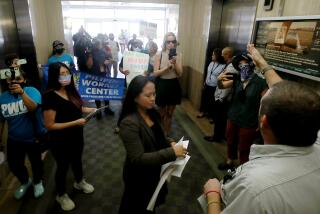Study Cites Social Costs of Wal-Mart
Inadequate wages and benefits force workers at Wal-Mart stores in California to seek $86 million a year in state aid, according to a report released Monday by the UC Berkeley Labor Center.
Moreover, if other retailers cut their wages and benefits to the levels offered by Wal-Mart Stores Inc., the cost to California’s public-assistance programs would rise by $410 million annually, the study said.
In their report, Berkeley researchers Arindrajit Dube and Ken Jacobs contend that more than other retail workers, Wal-Mart employees rely on a variety of public-aid programs, including food stamps, Medicare and subsidized housing.
“In effect, Wal-Mart is shifting part of its labor costs onto the public,” the researchers wrote. “Wal-Mart’s long-term impact on compensation in the retail industry has the potential to place a significant strain on the state’s already heavily burdened social safety net.”
Bentonville, Ark.-based Wal-Mart, the world’s largest retailer, maintains that it pays competitive wages and relieves public assistance burdens by giving jobs to many people who otherwise would not be employed.
“It’s unfortunate that these UC Berkeley researchers would release a study whose findings are questionable,” Wal-Mart spokeswoman Cynthia Lin said. The company employs more than 60,000 people in California.
The public debate about whether Wal-Mart benefits or hurts local communities has grown considerably louder over the last few years, particularly in California, where some communities have opposed the company’s expansion plans.
The company’s wage and benefit structure was also cited as a reason behind last year’s strike and lockout of unionized grocery workers in Southern California; the largest supermarket chains said they needed to revamp costs to compete with the retail giant.
Dube and Jacobs’ study took into account statewide data on wages paid by large retailers, the numbers of workers throughout the retail industry who use state assistance programs and information gleaned from lawsuits about Wal-Mart’s pay and benefits.
Dube, of Berkeley’s Institute of Industrial Relations, and Jacobs, of the school’s Center for Labor Research and Education, said they did not contact Wal-Mart in preparing their report.
The report found that Wal-Mart’s wages on average were 31% below those of the broader group of large retailers -- $9.70 an hour versus $14.01 an hour.
And with less earning power, Wal-Mart workers rely more heavily on state resources, Dube and Jacobs found, costing the state $32 million in health-related expenses and $54 million in other assistance.
The study contends that the average non-management Wal-Mart employee receives $1,952 in public assistance compared with $1,401 for workers at large retailers in general.
“The disproportionate use by Wal-Mart workers of the various healthcare and social safety net programs, and the cost that that brings to the state, is an important consideration for policymakers,” Jacobs said in an interview.
Dube and Jacobs noted that other studies have reported similar findings.
In Georgia, a state survey of the state’s children’s health insurance program found that Wal-Mart employees’ families disproportionately relied on the program, accounting for more than 10,000 of the 166,000 children enrolled.
In Congress, a report by Democratic staffers on the House Committee on Education and the Workforce looked at employee eligibility for assistance programs and found that a typical 200-employee Wal-Mart store could cost federal taxpayers $420,750 a year, or more than $2,000 per employee.
Wal-Mart has disputed those findings.
More to Read
Inside the business of entertainment
The Wide Shot brings you news, analysis and insights on everything from streaming wars to production — and what it all means for the future.
You may occasionally receive promotional content from the Los Angeles Times.










